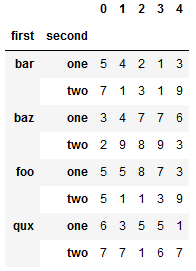分层/多级索引能在较低纬度的数据结构(如Series和DataFrame)中存储和操作任意维度的数据,
1. 创建MultiIndex
MultiIndex对象是标准索引Index对象的扩展,可以将MultiIndex看作一个元组数组,其中每个元组都是唯一的。可以从数组列表(MultiIndex.from_arrays())、元组数组(MultiIndex.from_tuples())、交叉迭代器集(MultiIndex.from_product())或DaTaFrame(使用using MultiIndex.from_frame)创建多索引。当传递一个元组列表时,索引构造函数将尝试返回一个MultiIndex。
1. from_tuples
先创建一个元组构成的列表
import pandas as pd arrays = [['bar', 'bar', 'baz', 'baz', 'foo', 'foo', 'qux', 'qux'], ['one', 'two', 'one', 'two', 'one', 'two', 'one', 'two']] tuples = list(zip(*arrays)) print(tuples)
将元组列表转换为MultiIndex:
MultiIndex.from_tuples(tuples, sortorder=None, names=None)
index = pd.MultiIndex.from_tuples(tuples, names=('first', 'second')) index
创建一个Series,并设置它的index:
import numpy as np s = pd.Series(np.random.randn(8), index=index) s
first second
bar one -1.219790
two -1.299911
baz one -0.707801
two 0.280277
foo one 0.683006
two 1.279083
qux one -0.659377
two 0.095253
dtype: float64
创建一个DataFrame,并设置它的index:
df=pd.DataFrame(np.random.randint(1,10,(8, 5)),index=index)
df

2. from_arrays
如果说from_tuples接受的参数是“行”的列表,那么from_arrays接受的参数就是“列”的列表:
MultiIndex.from_arrays(arrays, sortorder=None, names=None)
arrays = [['bar', 'bar', 'baz', 'baz', 'foo', 'foo', 'qux', 'qux'], ['one', 'two', 'one', 'two', 'one', 'two', 'one', 'two']] index = pd.MultiIndex.from_arrays(arrays) s = pd.Series(np.random.randn(8), index=index) s
bar one 0.817429
two 0.248518
baz one -0.684833
two 0.437428
foo one -0.019753
two -1.035943
qux one 1.602173
two -1.592012
dtype: float64
为了方便,通常可以直接在Series的构造函数中使用:
arrays = [['bar', 'bar', 'baz', 'baz', 'foo', 'foo', 'qux', 'qux'], ['one', 'two', 'one', 'two', 'one', 'two', 'one', 'two']] s = pd.Series(np.random.randn(8), index=arrays) s
3. from_product
假如有两个list,这两个list内的元素相互交叉,两两搭配,这就是两个list的product:
MultiIndex.from_product(iterables, sortorder=None, names=None)
lists = [['bar', 'baz', 'foo', 'qux'], ['one', 'two']] index = pd.MultiIndex.from_product(lists, names=['first', 'second']) s = pd.Series(np.random.randn(len(index)), index=index) s
first second
bar one 1.131558
two -2.186842
baz one -0.045946
two 1.376054
foo one 1.384699
two -0.141007
qux one -0.474400
two 1.402611
dtype: float64
2. 特征选取作为pipeline(管道)的一部分
特征选择通常在实际的学习之前用来做预处理。在scikit-learn中推荐的方式是使用:sklearn.pipeline.Pipeline
clf = Pipeline([ ('feature_selection', SelectFromModel(LinearSVC(penalty="l1"))), ('classification', RandomForestClassifier()) ]) clf.fit(X, y)
在这段代码中,利用 sklearn.svm.LinearSVC 和 sklearn.feature_selection.SelectFromModel 来评估特征的重要性并选择相互相关的特征。
来自:Python开发最佳实践